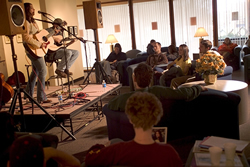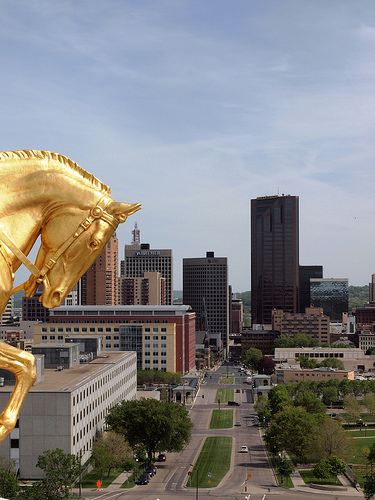Copyright
The Minnesota State Board of Trustees recognizes and affirms the rights of copyright owners. Members of our broad teaching and learning community should take reasonable care to acknowledge and preserve these rights.
Copyright Resources
Related Policies
Additional Information
U.S. copyright law is grounded in the Patent and Copyright clause of the United States Constitution. Over the years, courts have liberally interpreted the provisions of this clause to protect "writings" using new technologies.
In 1790, Congress enacted the first copyright act. The act has been revised many times since.
The Copyright Act of 1976: became effective January 1, 1978, and protects works created since 1978. (Works created prior to that date continue to be governed by the 1909 act.) Among other things, the 1976 Act eliminated the distinction between unpublished and published works. In addition, it provided that copyright protection become automatically available at the time that a work is created or fixed in some tangible form.
Amendments to 1976 Act: There have been several key amendments to copyright law even since the 1976 Act. For example, in 1980, copyright protection was extended to computer programs. Copyright holders also no longer have to use the copyright symbol, "©", to protect their works.
In 1998: Copyright protection was extended from 50 to 70 years after the death of the author. For works made for hire and anonymous works, the period of copyright was extended to 95 years from publication, or 120 years from creation, whichever is shorter.This law, also known as the "Sonny Bono Copyright Term Extension Act", "Sonny Bono Act", or pejoratively as the "Mickey Mouse Protection Act", effectively "froze" the advancement date of the public domain in the United States for works covered by the older fixed term copyright rules. Under this Act, additional works made in 1923 or afterwards that were still copyrighted in 1998 will not enter the public domain until 2019 or afterward (depending on the date of the product) unless the owner of the copyright releases them into the public domain prior to expiration, or will continue to be withheld if the copyright gets extended again.
The most recent change to copyright law directly affects higher education. In the fall of 2002, Congress passed the Technology, Educational and Copyright Harmonization Act (TEACH Act). The TEACH Act revised the section of copyright law that deals with the performance and display of others' works in distance education settings and prescribes new rules for faculty members at institutions with students in remote classrooms, online courses, or other distance education settings.

© Live Performance, Rochester Community & Technical College
The photograph, taken with permission of the individuals included as subject matter, is an original creation (a pictorial or graphic work) protected by copyright law. In fact, the photograph itself depicts a copyrighted work: a musical performance. The musicians featured in the photograph likely were performing a copyrighted musical work, as well. Perhaps it was a work they authored themselves, or perhaps it was another musician's work (in which case, their public performance of the music may have been subject to copyright restrictions, too!). Amazing, isn't it? Who would have guessed that a single work of art could produce such a discussion of copyright!
What is Eligible for Copyright?
Copyright law protects original works of authorship fixed in a tangible medium of expression. Copyright protection is automatic and works are protected from the moment they are created (whether they bear the © symbol or not). Included among such original works are the following:
- Literary works
- Musical works, including any accompanying words
- Dramatic works, including any accompanying music
- Pantomimes and choreographic works
- Pictorial, graphic and sculptural works
- Motion pictures and other audiovisual works
- Sound recordings
- Architectural works
What is NOT eligible for copyright?
By law, certain works are not eligible for copyright protection. Accordingly, there are no restrictions on the use, photocopying, and reproduction of these works. Unprotected works fall into the following categories:
- Works in the Public Domain: including works that never were copyrightable, as well as those for which the copyright has expired. It is not always easy to determine if a work is in the public domain. Different works (depending on when they were first published or created) fall under different sections of the copyright law and recent revisions to the law (including the Sonny Bono Copyright Term Extension Act of 1998) have lengthened the term of copyright protection for some works. One sure rule of thumb is that works published before 1923 are in the public domain.
- Government Publications: works prepared by an officer or an employee of the U.S. government as a part of that person's official duty are not copyrightable. For instance, legislation authored by a United States senator is not copyrightable; but a book written by the same senator about his or her experiences on Capitol Hill is because such a book would not be written as part of the senator's official duty. Note that this government publications exception applies only to works of the U.S. government, however. Works of other governmental bodies, such as states, counties and cities, are copyrightable and can only be reproduced in accordance with law.
- Non-copyrightable Works: works not fixed in a tangible medium of expression or that employ less than "minimal creativity" are not copyrightable. These include principles, ideas, processes, concepts, discoveries, procedures, systems, and methods of expression. For instance, copyright protection does not apply to slogans like Wendy's Hamburger's "where's the beef?" or Ford Truck's "like a rock." Keep in mind, though, that some of non-copyrightable concepts or ideas may be eligible for patent or trademark protection.
- Statutory Exceptions: In some instances, works that may otherwise be protected may be used without permission because the particular use being made of them falls within a statutory exception to the copyright law. Statutory exceptions include the exception for face-to-face teaching activities of non-profit groups and the exceptions for distance learning activities described in the TEACH Act.

Photograph courtesy of and ©2009, Annalee Garletz, St. Paul with limited use rights granted via Creative Commons.
Copyright owners have certain exclusive rights. These include the right to reproduce their work; to distribute their work; to create derivative works; to publicly display their work; and to publicly perform their work.
Non-owners often infringe on these rights when they engage in common activities like photocopying, downloading files, posting works (for example, photographs, graphics, text and sound) to a website, showing films and performing dramatic works like plays and songs.
The copyright holder (and in this case, also the photographer) of the photograph at right (Annalee Garletz) has all of the above rights with regard to the photograph. The copyright holder alone may use the work or grant permission to others to use the work. In the past, some artists have granted museums the right to display their works. They also have granted at least one museum the right to create a derivative work.
In the 1980's, when "Jammin At The Savoy" a painting by Romare Beardon, was displayed by the Brooklyn Museum, the museum sought permission and obtained the right to make posters of the painting. The posters identified the artist and bore the name of the painting. They also included the museum's name and the dates of the show at which the painting was displayed. These posters were sold by the museum, subject to a licensing agreement with the copyright owner, a likely condition of which was that a portion of the proceeds would be paid to the owner.
Unless a work falls within one of the exceptions above, or your intended use of a work constitutes "fair use", you may only use the work with the permission of the copyright owner.
Please see frequently asked questions about obtaining permissions.
Because the Bearden painting is a copyrighted work, and we were not sure whether our use of the painting would be deemed "fair use," we sought permission from the copyright holder to reproduce it for use on this website, but were not successful.
Royalties and Fees
No Minnesota State faculty member or staff person shall commit to pay a royalty, license, or other fee to a copyright owner without first obtaining the approval of the campus Intellectual Property Coordinator. With regard to negotiating royalties, licenses, and other fees, it often is helpful to use the services of copyright clearing house associations. For a listing of clearinghouses by category of work, see our Copyright Clearinghouse Roster.
We did not obtain permission to use the Bearden painting discussed on this website, but sought the assistance of the Visual Artists and Galleries Association, Inc. (VAGA), an intellectual property rights coordinator that contacts the copyright owner and negotiates the terms of a licensing agreement. Obtaining the permission of the copyright owner is just the first step, however.
Because we were dealing with a work of art (and because we could not download or scan the actual painting), we also had to request permission to use a photographer's two-dimensional photographic image (a slide) of the painting from which we could produce the electronic image. Again, VAGA provided assistance in contacting the copyright owner and negotiating the rental of the slide.